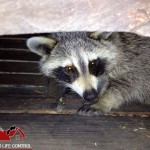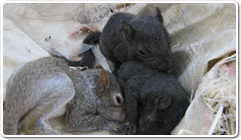 Raccoons are a type of mammal that are native to North America. They are considered a pest as they can destroy lawns, cause damage to property and even carry harmful diseases such as rabies. Apart from visually sighting a raccoon, there are several other ways you can identify them. This article takes a look at some of the most common signs of a raccoon infestation, and it also explains what you can do if you think that you have an infestation.
Raccoons are a type of mammal that are native to North America. They are considered a pest as they can destroy lawns, cause damage to property and even carry harmful diseases such as rabies. Apart from visually sighting a raccoon, there are several other ways you can identify them. This article takes a look at some of the most common signs of a raccoon infestation, and it also explains what you can do if you think that you have an infestation.
Raccoon Noises
One way you can identify a raccoon infestation is by listening out for any unusual noises. These can include scampering, scratching or chattering noises coming from your attic area, or from underneath the home. Noises can indicate that you have a raccoon infestation, but it may also mean that you have another type of infestation, such as a rodent problem.
Damage to Your Property
There are several physical signs that a raccoon is living either in or around your property. You can inspect the external area of your home to look for signs of shingles that have been removed from the roof area. You can check for damaged vents around the property, or signs of scratching on boards or vents outside of your home. Also check for garbage that has been scattered from your garbage cans, as raccoons are notorious for doing this. Finally take a look out for any rolled up sod on your lawn area as well as destroyed garden crops. Again these signs may help to indicate that you have an infestation, but they could also mean that you have another type of infestation such as a skunk, squirrel or fox infestation depending on the country or area that you live in. If you have any of the above signs it is worth calling in an infestation specialist.
Urine and Faeces
Another way to check for raccoons is to look for signs of raccoon feces or urine either in or around your property. Take a look in areas where raccoons are likely to infest, such as attic spaces, chimneys and vents as well as under your home. If you notice any form of faeces in your home then avoid touching or going near them, as they can often contain harmful bacteria and diseases. Instead call your local infestation team who can remove them quickly and safely.
If you are still unsure as to whether you have a raccoon infestation or not then you should call an infestation specialist to come and take a look for you. They will have the skills and expertise to identify whether or not you have a problem, and what they can do to remove the pests.
At Sand Wildlife Control we offer a range of services and our professional team are on hand to remove pests in the most humane way possible. We are able to deal with a number of pests including skunks, opossums, pigeons, bats, startling, sparrows and squirrels. You can contact us via our online form on our website, by email or by telephone.


